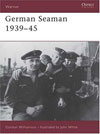As early as 1917, alternatives to the detection of submarines by hydrophones were being studied. One such area for consideration was the use of magnetism. In 1918 the U.S experimentally tried a ship towed magnetic detection device. This device was found to have too limited a detection range and also suffered from the presence of the magnetic signature of the towing ship. For the time being, magnetic detection was abandoned as impractical.
With the outbreak of WW II, renewed interest occurred in alternative detection systems for anti-submarine warfare. For aircraft there was a pressing need to devise a means for them to be able to detect a submerged submarine. One of the devices that received renewed attention was the use of magnetic anomaly detection.
As early as 1941 magnetic detection devices (which measure changes in the Earth's magnetic field) had been developed in both Britain and the U.S. The first airborne use of these devices was in U.S. K type blimps. This was followed by much wider installation of MAD devices in ASW patrol aircraft. By 1943 most ASW aircraft were equipped with MAD.
Initially, the U.S. thought that MAD would be a primary means of detecting submerged submarines. In use MAD was found to be a system of limited usefulness. This was due to its very limited range and, its inability to distinguish between sources of magnetic variance. Frequently, wrecks or local magnetic disturbances were classified as submarines. This was particularly true earlier in the war before experience with the system had discovered its limitations.
By late war, MAD in combination with sonobuoys proved more useful. In combination, MAD allowed an aircraft to localize a contact made with sonobuoys and, the sonobuoys provided confirmation that the contact was, indeed, a submarine. In this combination MAD became the secondary system to the sonobuoy, the reverse of what was originally expected.
Written by Terry A. Gardner


